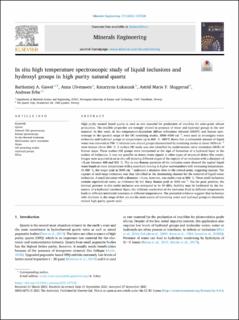| dc.contributor.author | Gawel, Bartlomiej | |
| dc.contributor.author | Ulvensøen, Anna | |
| dc.contributor.author | Lukaszuk, Katarzyna Anna | |
| dc.contributor.author | Muggerud, Astrid Marie Flattum | |
| dc.contributor.author | Erbe, Andreas | |
| dc.date.accessioned | 2021-10-12T07:45:38Z | |
| dc.date.available | 2021-10-12T07:45:38Z | |
| dc.date.created | 2021-10-07T16:53:09Z | |
| dc.date.issued | 2021 | |
| dc.identifier.issn | 0892-6875 | |
| dc.identifier.uri | https://hdl.handle.net/11250/2789144 | |
| dc.description.abstract | High purity natural based quartz is used as raw material for production of crucibles for solar-grade silicon production. The crucible properties are strongly related to presence of water and hydroxyl groups in the raw material. In this work, in situ temperature-dependent diffuse reflectance infrared (DRIFT) and Raman spectroscopy in the spectral range of the OH stretching modes, 3000–4000 cm−1, were used to investigate water inclusions and hydroxyl groups at temperatures up to 800 °C. DRIFT shows that a substantial amount of liquid water was removed at 700 °C whereas new silanol groups characterised by stretching modes at about 3650 cm−1 were formed above 200 °C. A surface OH mode was also identified by multivariante curve resolution (MCR) of Raman maps. These surface OH groups were interpreted as the sign of formation of a hydrated layer at the surface of inclusions. It was not possible to detect water signals in other types of structural defect like cracks. Images were acquired in an in situ cell showing different stages of the rupture of an inclusion with a diameter of 8 μm between 400 and 500 °C. The in situ Raman spectrum of the inclusion water showed the typical liquid water bands at room temperature with a maximum moving to higher wavenumbers with increasing temperature. At 400 °C, the single peak at 3645 cm−1 indicated a situation close to the critical point, triggering rupture. The rupture of such large inclusions was thus identified as the dominating channel for the removal of liquid water inclusions. A small inclusion with a diameter 4 μm, however, was stable even at 800 °C. These small inclusions contain supercritical water, as evidenced by the sharp Raman peak at 3600 cm−1. Via the peak position, the internal pressure in this stable inclusion was estimated to be 90 MPa. Stability may be facilitated by the formation of a hydrated interfacial layer; the different reactivities of the inclusion fluid at different temperatures leads to different interfacial structures at different temperatures. The presented evidence suggests that inclusions with diameter in the range of few μm are the main source of remaining water and hydroxyl groups in thermally treated high purity quartz sand. | en_US |
| dc.language.iso | eng | en_US |
| dc.publisher | Elsevier | en_US |
| dc.rights | Navngivelse 4.0 Internasjonal | * |
| dc.rights.uri | http://creativecommons.org/licenses/by/4.0/deed.no | * |
| dc.title | In situ high temperature spectroscopic study of liquid inclusions and hydroxyl groups in high purity natural quartz | en_US |
| dc.type | Peer reviewed | en_US |
| dc.type | Journal article | en_US |
| dc.description.version | publishedVersion | en_US |
| dc.source.volume | 174 | en_US |
| dc.source.journal | Minerals Engineering | en_US |
| dc.identifier.doi | 10.1016/j.mineng.2021.107238 | |
| dc.identifier.cristin | 1944263 | |
| cristin.ispublished | true | |
| cristin.fulltext | original | |
| cristin.qualitycode | 2 | |

